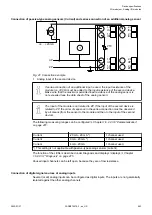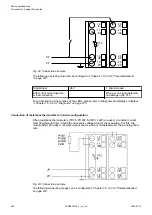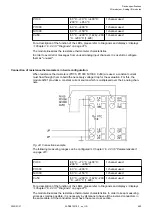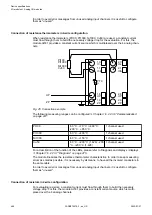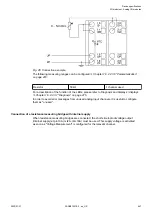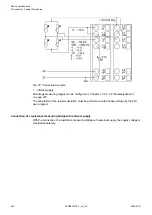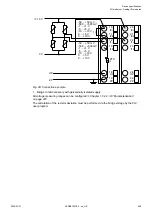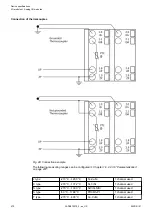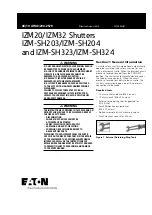
The modules are plugged on an I/O terminal unit
Chapter 1.5.2 “TU515, TU516, TU541 and
TU542 for I/O modules” on page 126
. Properly position the modules and press until they lock
in place. The terminal units are mounted on a DIN rail or with 2 screws plus the additional
accessory for wall mounting (TA526
Chapter 1.8.2.6 “TA526 - Wall mounting accessory”
The connection of the I/O channels is carried out using the 40 terminals of the I/O terminal unit.
I/O modules can be replaced without re-wiring the terminal units.
The terminals 1.8, 2.8, 3.8, 4.8, 1.9, 2.9, 3.9 and 4.9 are electrically interconnected within the
I/O terminal units and always have the same assignment, independent of the inserted module:
Terminals 1.8, 2.8, 3.8 and 4.8: process voltage UP = +24 V DC
Terminals 1.9, 2.9, 3.9 and 4.9: process voltage ZP = 0 V
The assignment of the other terminals:
Terminals
Signal
Description
2.0, 2.2, 2.4, 2.6
I0+ to I3+
Positive poles of the first 4
analog inputs
1.0, 1.2, 1.4, 1.6
I0- to I3-
Negative poles of the first 4
analog inputs
2.1, 2.3, 2.5, 2.7
I0A to I3A
Connections A (supply) of the
first 4 analog inputs
1.1, 1.3, 1.5, 1.7
I0B to I3B
Connections B (analog
ground) of the first 4 analog
inputs
4.0, 4.2, 4.4, 4.6
I4+ to I7+
Positive poles of the following
4 analog inputs
3.0, 3.2, 3.4, 3.6
I4- to I7-
Negative poles of the fol-
lowing 4 analog inputs
4.1, 4.3, 4.5, 4.7
I4A to I7A
Connections A (supply) of the
following 4 analog inputs
3.1, 3.3, 3.5, 3.7
I4B to I7B
Connections B (analog
ground) of the following 4
analog inputs
CAUTION!
Analog sensors must be galvanically isolated against the ground. In order to
avoid inaccuracy with the measuring results, the analog sensors should also be
isolated against the power supply.
The "IxB" clamps (x=0..7) of the analog inputs are galvanically connected to
each other. They form an "Analog Ground Signal" (AGND) for the module.
The negative poles of the analog inputs Ix- may accept a potential difference
up to
±
20 V DC with regard to the common reference potential IxB (AGND,
ZP). Observing this maximum voltage difference, analog current inputs of one
module can be switched in series to each other and also with current inputs of
other modules.
Device specifications
I/O modules > Analog I/O modules
2022/01/31
3ADR010278, 3, en_US
455























